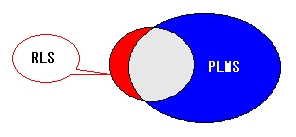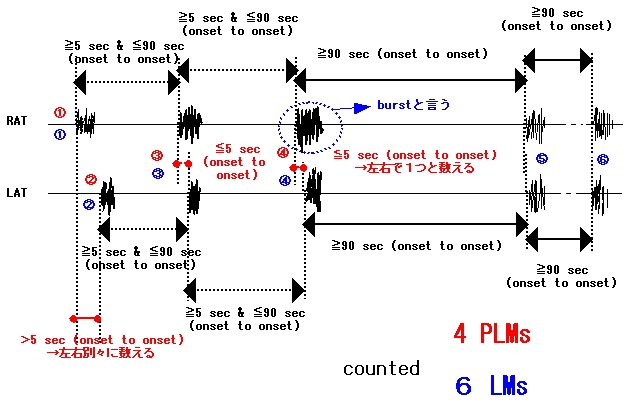傓偢傓偢懌徢岓孮 (俼俴俽) 偺俇侽乣俉侽亾偵崌暪偡傞乮媡偼恀側傜偢乯偑丄俼俴俽偑壓巿偺
晄夣側姶妎偱偁傞偺偵懳偟丄俹俴俵俢偼恊巜丄懌娭愡偺攚孅塣摦偱偁傝丄廃婜揑 (婯懃揑) 偵
偍偙傞晄悘堄塣摦偱偁傞丅乮R/O "悋柊偰傫偐傫" 偱偼廃婜惈偼傒傜傟側偄乯
RLS偼before sleep (擖柊慜) 偺幘姵偱偁傝丄
PLMD偼after(=during) sleep(擖柊屻=婛偵悋柊偵擖偭偰偄傞帪偵婲偙傞)偺幘姵偱偁傞丅
愺偄僲儞儗儉悋柊偱婲傝傗偡偔丄怺偄僲儞儗儉悋柊傗REM悋柊偱偼杦偳傒傜傟側偄丅
PLMS RLS
SLEEP after sleep before sleep
DIAGNOSIS polysomnographic clinical
periodic (rhythmic) leg (arm) movements, such as dorsiflexion (extension)
of the big toe with fanning of
the small toes, accompanied by flexion of the ancles,
knees and hip that may or may not be associated with arousal.
丒Only a small fraction (30%) of all patients with PLMD have RLS. Thus, the abscence of a history of RLS
does not diminish the possibility of the presence of PLM. In contrast, if a patient has RLS, he or she
also has PLM (70-90%).

亙PLMS scoring (1993 ASDA American Sleep Disorders Association)亜
During sleep (scored only on those epochs which the patients are asleep) ;
1) 0.5 to 5 second duration (lasting) of burst of anterior tibialis activity
2) an amplitude of at least 25% of the bursts recorded during biocalibration(=voluntary toe dorsiflexion)(妎惲帪偺悘堄廂弅)
伀
1)and2)偺忦審偑偦傠偊偽 is scorred "leg movement(LM)"
leg movement(LM)偑峏偵壓婰3)偺periodic偺忦審傪枮偨偣偽is scored "PLM"
伀
3) a series of 4 events (burst) separated by intervals of 5(4) to 90 seconds
(occuring every 5 to 90 seconds)
(measured from leg movement onset to leg movement onset)
伀
PLM during sleep傪"PLMS"偲尵偆
4) limb movements preceeded by spontaneous arousal(=following arousal), or resulting from arousals
associated with the termination of a respiratory event(=apnea termination) are not scored as PLMs.
(柍屇媧廔寢帪偺妎惲斀墳偵堦抳偟偰婲偙傞)
丒hypnic jerks悋柊帪嬝澒弅亖sleep starts悋柊帪傂偒偮偗乮傃偔偮偒乯亖hypnagogic jerks擖柊帪嬝澒弅亖stage1
偵帄傞慜偺偆偲偆偲偲柊傞忬懺偱弌尰偟丄擖柊偡傞偲婲偙傜側偄丅偙傟傕before sleep屘not scored
5) simultaneous movements in both legs are counted one movement(=in the two- channel method of
丂丂丂丂伀 display).
丂丂unless the second leg movement is more than 5 seconds after the onset of the first
(some use 5 seconds after the offset of the first leg movement)

丒PLMS index(/hour)亖number of PLMS per hour of sleep亖total number of PLMs / (TST(min)/60min) ;
greater than 5 is considered pathologic; 5 to 24 mild, 25 to 49 moderete, 亞 50 severe
丒PLMS-arousal index(/hour)亖total number of PLMs associated with arousal / (TST(min)/60min) ;
亜25/hr in severe insomnia or EDS.丂丂丂丂 伀
to be scored as PLM with arousal , an arousal must occur simultaneously with a LM or
following the LM by less than(亙) 3 seconds
俬値倲倕倰値倎倲倝倧値倎倢 俠倢倎ssification of Sleep Disorders Criteria for PLMS Severity
SEVERITY PLM INDEX(/HR) PLM AROUSAL INDEX(/HR)
Mild 5-24 Not specified
Moderate 25-49 Not specified
Severe 亞50丂丂丂丂丂丂丂丂丂丂丂丂丂丂亜25/倛倰丂丂丂丂丂丂丂丂丂丂丂丂丂丂丂丂丂
丒monitoring of both legs(=dual monitoring) is suggested., because PLM may occur in one or both legs.
丒PLMs are restricted to NREM sleep in many patients(stage1偵擖傞偲偡偖弌尰偟stage2偱昿夞偲側傝丄
stage3乣4偱偼尭彮偡傞),(捠忢REM悋柊偱偼弌尰偟側偄) but PLMs in REM sleep can occur (廳徢椺).
丒Patients usually do not remember PLMs, but bedmates may report movement.
丒K-alpha complex (K-complex 偲懘傟偵懕偔 兛攇偺孮敪) 偑傒傜傟傞丅
丒PLMS and Microarousal : rule to score MA (ASDA : The American Sleep Disorders Association)
in NREM sleep, MA are defined as a return to alpha or theta activity lasting between 3 and 15
seconds.
in REM sleep, criteria include, in addition to EEG changes, an increase in chin EMG amplitude.
丒俼俴俽偺擖柊忈奞傗嵞擖柊忈奞偵懳偟丄俹俴俵俢偼拞搑妎惲乮堦斢偵俀夞埲忋栚偑妎傔傞乯偺
尨場偲側傞偑丄拞搑妎惲偑彮側偗傟偽EDS(擔拞孹柊)偺尨場偵偼側傜側偄丅
sleep continuity (=sleep-maintenance) is desrupted by frequent awakenings (e.g., OSAS)
丒Functional Significance of PLMS :
Most authors have concluded that PLMS have little impact on nocturnal sleep or daytime vigilance.
Some have questioned whether PLMD is a real clinical entity. 酾 PLMS occur in many asymptomatic individuals.
丒俼俴俽摨條栭娫屻敿偐傜憗挬偵偐偗偰寉尭側偄偟徚幐偡傞丅僇僼僃僀儞傗旀傟偱憹埆偡傞丅
丒nasal CPAP偵傛傞OSAS偺帯椕奐巒屻丄柍屇媧偑尭彮偟偨偵傕娭傜偢丄晄柊傗夁柊偑夵慞
偟側偄帪偵偼丄 PLMs 偺弌尰傗憹埆偑尨場偐傕偟傟側偄丅偙偺帪偼PLMD偺帯椕傪偡傞丅
丒 Causes and Associations of PLMS
酲 any cause of RLS
酲 withdrawal of anticonvulsants, barbiturates, hypnotics
酲 associated with narcolepsy, OSA, RBD, CPAP titration
丂丂丂丂丂丂酾 in many asymptomatic individuals
帯椕丟RLS偲摨偠乮佹RLS偲PLMD偼昦懺偑嫟捠乯
丒 traditional偵偼儕儃僩儕乕儖KLONOPIN乮benzodiazepin clonazepam乯0.5乣1.0mg-->
嘆 decrease in the arousals associated with the leg movements, but no decrease in the number
of leg movements.嘇 pottential to worsen sleep apnea, 嘊 absolutely contraindicated in hypoventilation; should be used with caution in patients with OSA.
丒 alternative to the benzodiazepin 偼DA agents ;
嘆SINEMET(carbidopa/levodopa (25/100 mg) combination)=Dopamine precursors
-->decrease the amount of leg movements
OR
嘇 MIRAPEX(Pramipexole)=Dopamine agonists
乮拲堄乯DA agents may exert a stimulant (or an alerting) effect that might further disrupt
nocturnal sleep or EDS.